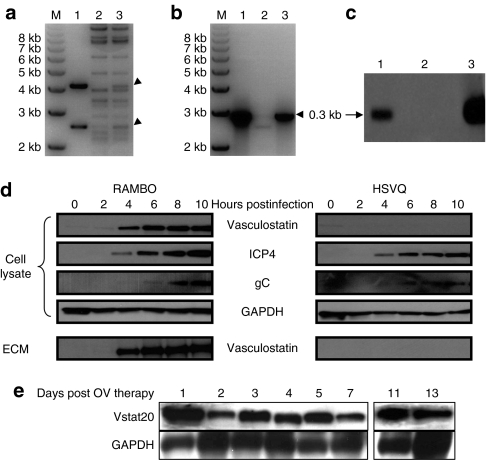Figure 2.
Verification of RAMBO and Vstat120 production in vitro and in vivo. (a) XhoI restriction digest of pVasculo-transfer plasmid expressing IE4/5 promoter-Vstat120 cassette (lane 1), control fHSVQ1-BAC (lane 2), and RAMBO-BAC (lane 3). The expected 4.2 and 2.5 kb restriction fragments are indicated by arrow heads. (b) PCR of recombinant RAMBO-BAC. DNA from control plasmid pVasculo-transfer (lane 1), fHSVQ1 (lane 2), or RAMBO-BAC (lane 3) was used as a template to detect the presence of Vstat120 gene by PCR using Vstat120-specific primers. (c) Southern blot analysis of HSVQ and RAMBO viral isolates digested with XhoI, and probed for a Vstat120-specific fragment. Hybridization of the expected 0.3 kb fragment to XhoI-digested DNA in RAMBO (lane 1) and pVasculo-transfer (lane 3) but not in HSVQ (lane 2) digested lanes is indicated by an arrow. (d) Immunoblot of LN229 glioma cells infected with RAMBO or HSVQ at a multiplicity of infection of 0.05. The cell lysate and ECM were harvested at 0, 2, 4, 6, 8, and 10 hours after infection as described in Materials and Methods. Temporal pattern of expression of Vstat120 was investigated by western blot analysis of the cell lysate and ECM. Note that the production of Vstat120 coincides with the turning on of the immediate early viral ICP4 gene. (e) Immunoblot of Vstat120 propagation in subcutaneous gliomas (U87ΔEGFR-Luc) treated with RAMBO in vivo over time. Mice with subcutaneous tumors were treated with a single intratumoral injection of RAMBO (8 × 105 plaque-forming units), and the mice were killed on days 1, 2, 3, 4, 5, 7, 11, and 13 following therapy. The harvested tumor was lysed and analyzed for expression of Vstat120 by western blot analysis. Note the detectable presence of Vstat120 within the tumor even 13 days after OV therapy. ECM, extracellular matrix; kb, kilobase; RAMBO, Rapid Antiangiogenesis Mediated By Oncolytic virus; Vstat120, vasculostatin.

